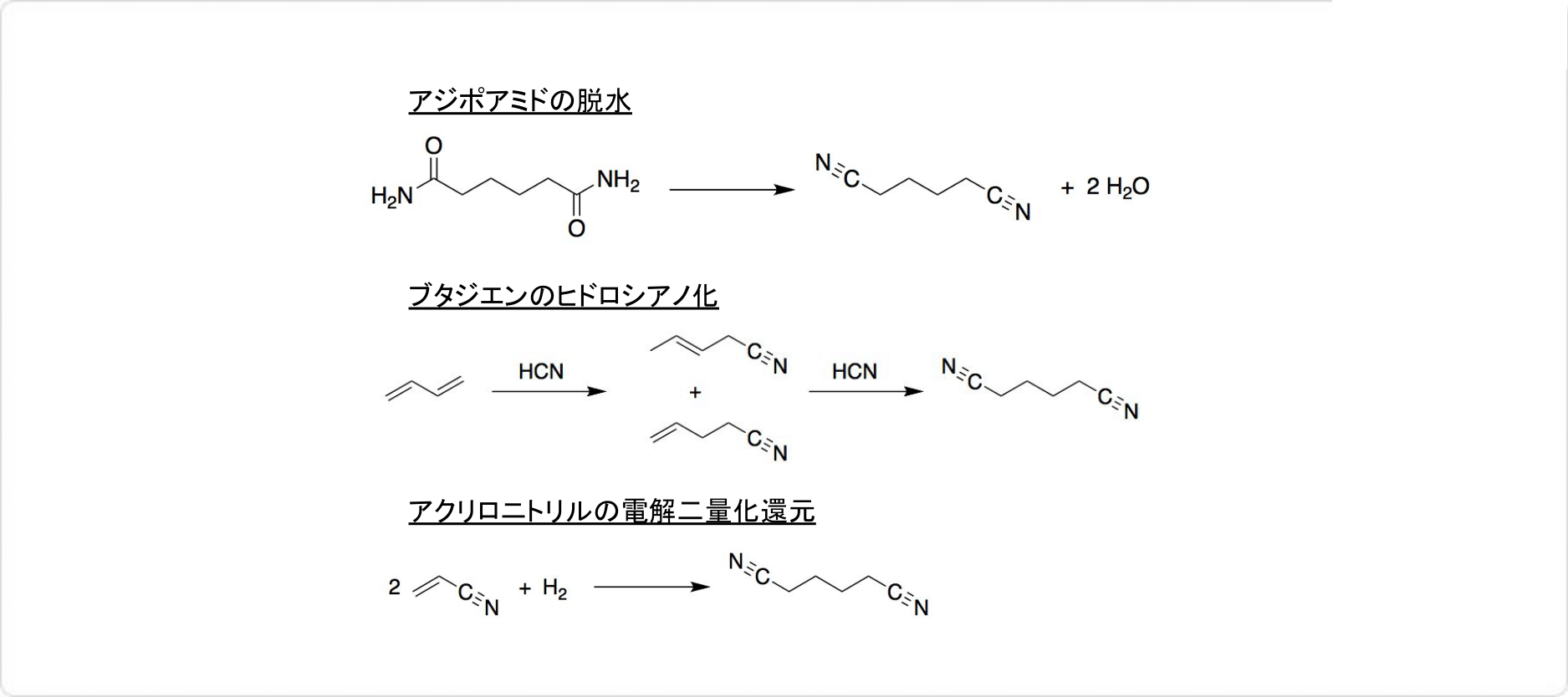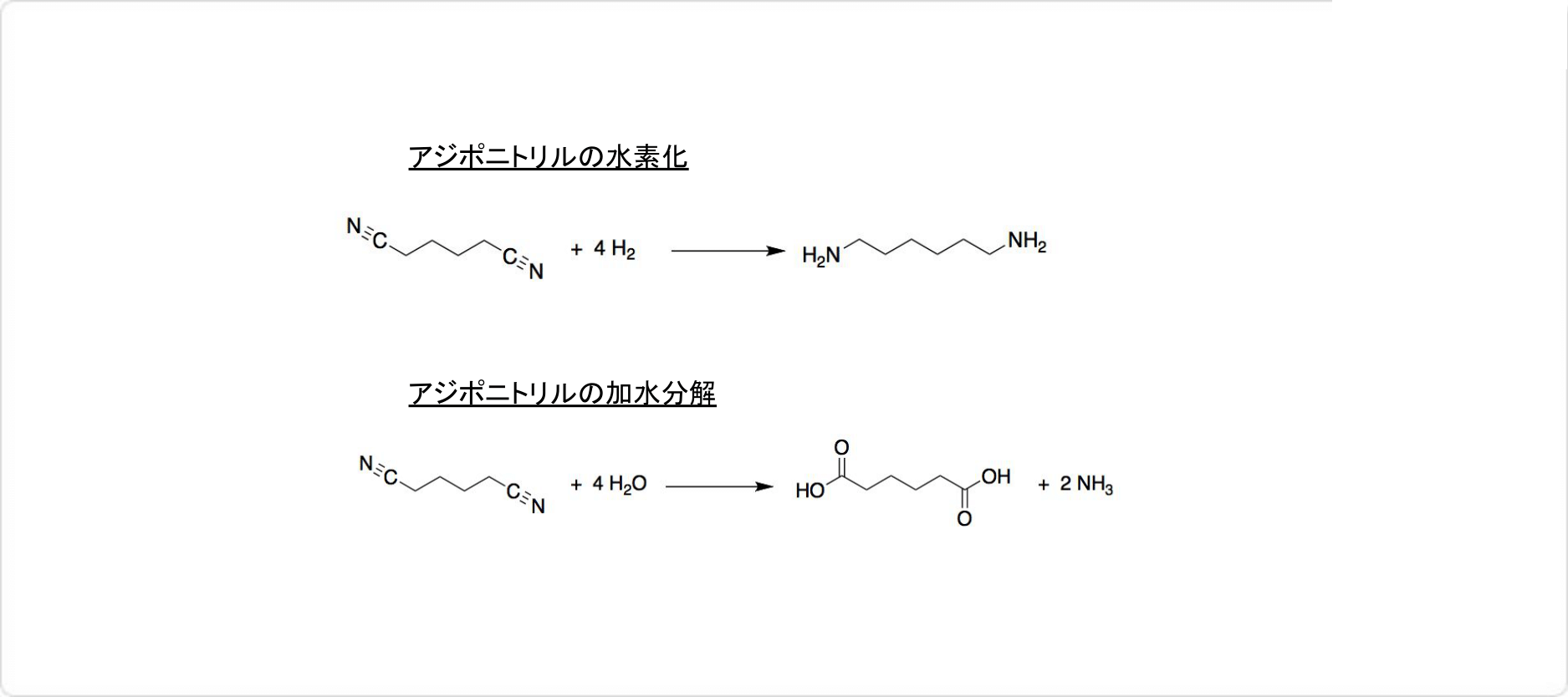アジポニトリル 化学特性,用途語,生産方法
外観
無色~黄褐色, 澄明の液体
性質
アジポニトリルは、水・・・に溶けます。融点は1°C、沸点は295°Cです。経口的に他のシアン化合物と同じく劇毒ですが、呼吸的には蒸気圧が低いため経皮的に危険性は少ないと言えます。
分子式はC6H8N2、分子量は108.14です。シアノ基を2つ持った有機化合物であり、示性式はNC(CH2)4CN、密度は0.97g/cm3です。
溶解性
水に可溶 (6g/100ml )。メタノール, エタノール, クロロホルムに可溶。四塩化炭素に難溶。二硫化炭素に不溶。エタノールに溶ける。
解説
hexanedinitrile.C6H8N2(108.14).NC(CH2)4CN.アジポニトリルは,ナイロン66の製造に用いられる重要な中間体.現在,工業的に下記3種類の原料ルートでその大部分が合成されている.(1)1977年に工業化された方法で,ブタジエンと青酸を銅-マグネシウムクロマイト触媒により気相で反応させ,主生成物として3-および4-ペンテンニトリルを得,これをニッケル系錯体触媒により,さらにシアン化水素酸と液相で反応させてアジポニトリルとする. "(2)シクロヘキサンの酸化で得られるアジピン酸にアンモニアを反応させて,生成するアジピン酸アンモニウムをリン酸系触媒で脱水する方法がもっとも一般的に行われている.
"(2)シクロヘキサンの酸化で得られるアジピン酸にアンモニアを反応させて,生成するアジピン酸アンモニウムをリン酸系触媒で脱水する方法がもっとも一般的に行われている. "(3)プロペンのアンモ酸化で得られるアクリロニトリルを電解二量化還元する方法が工業化されている.2CH2=CHCN + H2 → NC(CH2)4CN無色の液体.融点2.6 ℃,沸点295 ℃.d254 0.962.n20D1.4377.メタノール,エタノール,クロロホルムに可溶,水に可溶.水素化するとヘキサメチレンジアミンとなり,これとアジピン酸を縮重合してナイロン66が製造される.用途の大部分はナイロン製造用であるが,一部さび止め剤,ゴムの加硫促進剤の製造中間体としても用いられる.経口的には,ほかのシアン化合物と同様な劇毒であるが,呼吸的には蒸気圧も低く,経皮的にも危険性は少ない.森北出版「化学辞典(第2版)
"(3)プロペンのアンモ酸化で得られるアクリロニトリルを電解二量化還元する方法が工業化されている.2CH2=CHCN + H2 → NC(CH2)4CN無色の液体.融点2.6 ℃,沸点295 ℃.d254 0.962.n20D1.4377.メタノール,エタノール,クロロホルムに可溶,水に可溶.水素化するとヘキサメチレンジアミンとなり,これとアジピン酸を縮重合してナイロン66が製造される.用途の大部分はナイロン製造用であるが,一部さび止め剤,ゴムの加硫促進剤の製造中間体としても用いられる.経口的には,ほかのシアン化合物と同様な劇毒であるが,呼吸的には蒸気圧も低く,経皮的にも危険性は少ない.森北出版「化学辞典(第2版)
用途
還元してヘキサメチレンジアミンとして、6,6-ナイロンの一成分として使用される。
用途
有機合成原料。
合成
1. アジポニトリルの合成例

図2. アジポニトリルの合成法
一般的にアジポニトリルは、等を触媒として、アジポアミドを脱水することで得ることが可能です。工業化された方法には、をヒドロシアノ化することによる合成法があります。
それ以外にも、プロペン (英: propene) のアンモ酸化 (英: ammoxidation) で生じる (英: acrylonitrile) を、電解二量化還元すると生成します。
2. アジポニトリルの合成法の詳細
アジポニトリルは、アジポアミドの脱水で得られます。具体的には、の酸化によって生じるに、を反応させます。生成したアジピン酸アンモニウムを、リン酸系触媒を使用して脱水すると得ることが可能です。
のヒドロシアノ化でも合成できます。まず、銅-マグネシウムクロマイト触媒によって、青酸とブタジエンを気相で反応させると、3-ペンテンニトリル (英: 3-pentenenitrile) と4-ペンテンニトリル (英: 4-pentenenitrile) が主生成物として得られます。
これら生成物をニッケル系錯体触媒を用いて、さらに液相でシアン化水素酸と反応させることで、アジポニトリルを得ることが可能です。
化学的特性
Adiponitrile is a combustible, colorless transparent to yellow, oily liquid with a slight bitter taste. Soluble in methanol, ethanol, chloroform. Insoluble in water, cyclohexane, ether, carbon disulfide and carbon tetrachloride. It decomposes on heating to react violently with strong oxidants. Upon burning, the highly toxic hydrogen cyanide is produced.
使用
Adiponitrile is mainly used in the production of hexamethylenediamine for manufacturing nylon 6,6. Lesser uses include that in organic synthesis and in the preparation of adipoguanamine, which is used as an extractant for aromatic hydrocarbons. This chemical is an important intermediate for the manufacture of synthetic fiber.
製造方法
The main method of industrial production of adiponitrile is the amination of adipic acid. Adipic acid and excess ammonia are reacted in the presence of catalyst phosphoric acid or its salts or esters at a temperature of 270-290°C to generate diammonium adipate, which is then heated and dehydrated to generate crude adiponitrile, The product is obtained by rectification.
調製方法
Adiponitrile may be prepared by reacting butadiene with hydrogen cyanide, by the
electrodimerization of acrylonitrile, by heating adipamide with acetic anhydride in
the presence of cobalt or by reacting 1,4-dichlorobutane with sodium cyanide
(HSDB 1988). Impurities such as propionitrile, bis (cyanoethyl) ether or acrylonitrile
may be present depending on the method of manufacture (Smiley 1981).
一般的な説明
Adiponitrile appears as a colorless to light yellow liquid which is fairly soluble and is less dense than water. Contact may irritate skin, eyes and mucous membranes. May be toxic by ingestion, inhalation and skin absorption.
空気と水の反応
Insoluble in water.
反応プロフィール
1,4-Dicyanobutane is incompatible with strong oxidizers. 1,4-Dicyanobutane is also incompatible with strong acids, strong bases and strong reducing agents. .
健康ハザード
The acute toxicity of adiponitrile is somewhat lower than that of malononitrile. It is toxic by inhalation and oral routes. Inhalation of its vapors can cause nausea, vomiting, respiratory tract irritation, and dizziness. The symptoms are similar to those of other aliphatic mono- and dinitriles. Similar poisoning effects may be manifested from ingestion of this compound. However, its toxicity is very low from skin absorption.
Short et al. (1990) reported mortality and reduced weight gain in rats within one week after exposed to adiponitrile at 493 mg/m
3. However, at an exposure level of 99 mg/m
3 for 13 weeks the animals showed the sign of slight anemia but no histopathological evidence of organ toxicity.
LC50 value, inhalation (rats): 1710 mg/m
3/ 4 hr
LD50 value, oral (mice): 172 mg/kg
There is no report of its teratogenicity or cancer-causing effects in animals or humans.
火災危険
Combustion products may contain hydrocyanic acid (HCN). Vapor may explode if ignited in an enclosed area. When heated to decomposition, 1,4-Dicyanobutane emits highly toxic fumes. Avoid oxidizing material. Hazardous polymerization may not occur.
化学反応
1. アジポニトリルの反応

図3. アジポニトリルの反応
などを触媒として、アジポニトリルを水素化すると、 (英: hexamethylene diamine) となります。そして、加水分解によって、 (英: adipic acid) を得ることが可能です。アジポニトリルから生成するヘキサメチレンジアミンとアジピン酸を縮重合することで、ナイロン66が製造されています。
2. ナイロンの合成中間体としてのアジポニトリル
ナイロン66の合成中間体として、アジポニトリルは重要な化合物です。ナイロン66を得るために必要なヘキサメチレンジアミンとアジピン酸は、いずれもアジポニトリルから合成できます。
使用用途
アジポニトリルは、ナイロン66 (Nylon 66) の製造に用いられる重要な中間体で、用途の大部分はナイロン製造用です。ナイロン66には、高強度・耐摩耗性・電気絶縁性といった特性があり、電子機器や自動車、包装、建築、消費財などの用途に幅広く使用されています。
の原料として用いられる以外にも、さび止め剤やゴムの加硫促進剤の製造中間体としても用いられています。ガラス繊維などとのコンポジット化によって、自動車のとしても利用される場合が多いです。
工業用途
Adiponitrile is used in nylon manufacturing, synthetic fiber synthesis, and in the
manufacture of rubber accelerators and corrosion inhibitors. It is also used as an
extractant for aromatic hydrocarbons (Smiley 1981).
安全性プロファイル
Poison by inhalation, ingestion, subcutaneous, and intraperitoneal routes. The nitrile group wdl behave as a cyanide when ingested or absorbed in the body. It produces disturbances of the respiration and circulation, irritation of the stomach and intestines, and loss of weight. Its low vapor pressure at room temperature makes exposure to harmful concentrations of its vapors unlikely if handled with Flammable when exposed to heat or flame. When heated to decomposition it emits toxic fumes of CN-. Can react with oxidizing materials. To fight fire, use foam, CO2, dry chemical. See also HYDROCYANIC ACID and NITRILESreasonable care in well-venulated areas.
職業ばく露
Is used to manufacture corrosion inhibitors, rubber accelerators, and Nylon 66; and in organic synthesis.
環境運命予測
The mechanism of adiponitrile’s toxicity relates to its ability to
release cyanide both in vitro and in vivo. Cyanide then forms
a stable complex with ferric iron in the cytochrome oxidase
enzyme. Since this enzyme occupies a central role in the utilization
of oxygen in practically all cells, inhibition produces an
inhibition of cellular respiration.
代謝
Animal studies indicated that the concentrations of thiocyanate in the blood and
urine of guinea pigs injected with adiponitrile were proportional to the doses
administered. Following administration of adiponitrile, 79% was eliminated as
thiocyanate in the urine of guinea pigs (H?rtung 1982). Of the cyanide antidotes,
thiosulfate was most effective in protecting against adiponitrile poisoning, and
nitrite was less effective. However, on the basis of the ratio between administered
adiponitrile dose and quantity of cyanide detected, Ghiringhelli, (1955) concluded
that a greater part of the dose was metabolized to cyanide.
輸送方法
UN2205 Adiponitrile, Hazard Class: 6.1; Labels: 6.1-Poisonous materials
純化方法
Reflux adiponitrile over P2O5 and POCl3, and fractionally distil it, then fractionate it through an efficient column. The liquid is TOXIC and is an IRRITANT. [Braun & Rudolph Chem Ber 67 1770 1934, Reppe et al. Justus Liebigs Ann Chem 596 127 1955, Gagnon et al. Can J Chem 34 1662 1956, Copley et al. J Am Chem Soc 62 228 1940, Beilstein 2 IV 1947.]
不和合性
May form explosive mixture with air. Incompatible with oxidizers (chlorates, nitrates, peroxides, permanganates, perchlorates, chlorine, bromine, fluorine, etc.); contact may cause violent reactions: fires or explosions. Keep away from alkaline materials, strong bases, strong acids, oxoacids, epoxides. Also incompatible with strong reducing agents such as hydrideds and active metals. Permissible Exposure Limits in Air
廃棄物の処理
Add excess alcoholic KOH. Than evaporate alcohol and add calcium hypochlorite. After 24 hours, flush to sewer with water. Can also be incinerated with afterburner and scrubber to remove nitrogen oxides.
アジポニトリル 上流と下流の製品情報
原材料
準備製品